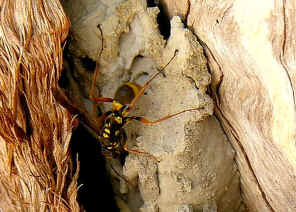Mud Nest Tenant Wasp - ? Auplopus sp.
FAMILY SPHECIDAE
This page contains pictures and information about Mud Nest Tenant Wasps that we found in the Brisbane area, Queensland, Australia.

- Body length 15mm
- At first we thought this wasp is Parasitoid of Mud-Dauber Wasp. Dr. Christian Schmid-Egger sent us a email advised that "this is a Pompilidae. It is something like Auplopus spec. or related. These genera also build mud nests, or use empty mud nests of Sphecids." This is a very interesting story. Please keep reading.


- The Mud-Dauber Wasp Sceliphron laetum build typical mud cell nest covered with extra layer of mud, as shown in the above picture. We never saw the S. laetum before. When we found a wasp wandering on mud cells (and took the following pictures), we thought this must be the S. laetum.
- Oct 2006 in Karawatha Forest, we followed a wasp to the nest of mud cells and the following those photos. The wasp checked the nest for half of a minute, bite off some mud near the edge of the cell entry (I thought it was putting mud on before carefully checked the photos), then it flied away. It came back after three minutes later, with empty hand, no mud and no prey. Then the wasp check the cell again and bite off a bit of mud on the other side before it flied away. Then I waited for about half an hour and the wasp did not come back. Since the cell was almost finish, I thought the wasp might have change its task from cell building to prey capturing. This may take some time so I did no keep on waiting.


- The wasp is slender with stalk-like petiole, followed by greatly swollen gaster. However, we discussed with Graeme Cocks and he commented that this wasp seems too small to be a S. laetum. We double checked and compare the drawings in the reference books, beside the mud cells, this wasp is nothing like a S. laetum.



I double checked all my photos taken that day. I found that the wasp was NOT building the cell. All I can say is it was examining, or even destroying, the cell. It actually bite off a bit of mud from the cell twice instead of putting mud on.


- If the wasp was not building the cell then it could be a parasite wasp. To bite off some mud make the smooth cell opening becomes rough, not good for final sealing, i.e., easier to open later for parasite.
- So this wasp is not the S. laetum, although it does look like a
SPHECIDAE. From R. J. Tillyard's book (listed in the reference), The Tachytes australis (or
Tachysphex australis) is known to attach and break open the cell
of S. laetum, using the stored provender of spiders as food for
its own larvae, and resealing the cell after its egg is laid. So we suspect
this wasp could be Mud-Dauber Wasp the Parasitoid Tachytes australis.


- Before........ One week later
- A week later we went back to where we found those the mud cells. We waited for
half an hour and did not see the any wasp. Then we collected all the mud
cells.
After returned home, we found the followings;
1. The mud cell we looked at last time was broken, it seemed that the host wasp had given up to use this cell.
2. A big cell at the top was newly built for, mud was still half dry, so we think we should have waited for a bit longer time to see the wasp.
3. Three mud cells there were holes on them. They were used and were empty. We found a very small piece of skin, could be pupa shell inside those cells. No insect or spider remains can be found.
4. Only one cell is all closed. I carefully open the cell from the back side. To my surprise, there were two compartments inside, as shown in the following picture. There was one larva in each compartment. No insect or spider remains can be found. I thought Sceliphron cell has only one compartment. We checked all the other used cells, they are single compartment.


- Today (15 Nov 2006) the larvae had turned into pupa, will keep look at them as see what will come out.
- Graeme Cocks has recorded two Ichneumon wasps came out from a S. formosum mud cell, which the cell was also two compartmented.
- Only one larva turned into pupa. The other did not turn into pupa. We might have damaged it when we open the mud cell.
-


- On 5 Dec 2006, one wasp came out..................................... this is a Mud Nest Tenant Wasp.
-



- We found this wasp again in Botanic Garden on Feb 2010. Above photos clearly show this is a wasp in family POMPILIDAE with its long legs, long spurs on legs and its antenna shape.
- This wasp has the colours and patterns of a VESPID wasp. Even its wings colour mimic the longitudinally folded wings.
- Dr. Christian Schmid-Egger sent us a email advised "this is a Pompilidae. It is something like Auplopus spec. or related. These genera also build mud nests, or use empty mud nests of Sphecids."
- Reference:
- 1. Scelephron laetum, Mud Dauber Wasp - Insects of Townsville, Australia, Graeme Cocks, 2004
- 2. Wildlife of Greater Brisbane - Ryan, Michelle (ed.), Queensland Museum, Brisbane, 1995, p116
- 3. Wasps of the genus Sceliphron (Hymenoptera: Sphecidae) intercepted in New Zealand - A. C. HARRIS Otago Museum, 1992
- 4. Insects of Australia, CSIRO, Division of Entomology, Melbourne University Press, 2nd Edition 1991, p 975, 990.
- 5. Insects of Australia and New Zealand - R. J. Tillyard, Angus & Robertson, Ltd, Sydney, 1926, p301.
- 6. Pompilidae - Insects of Townsville, Australia, Graeme Cocks, 2004
